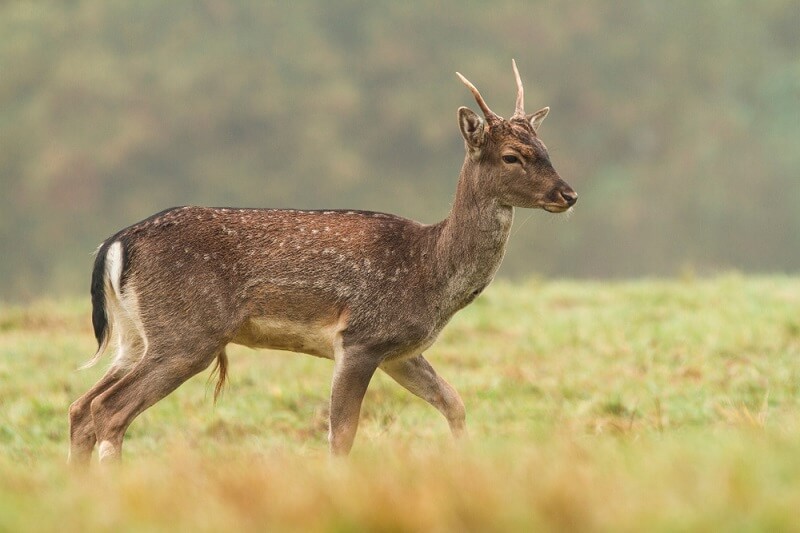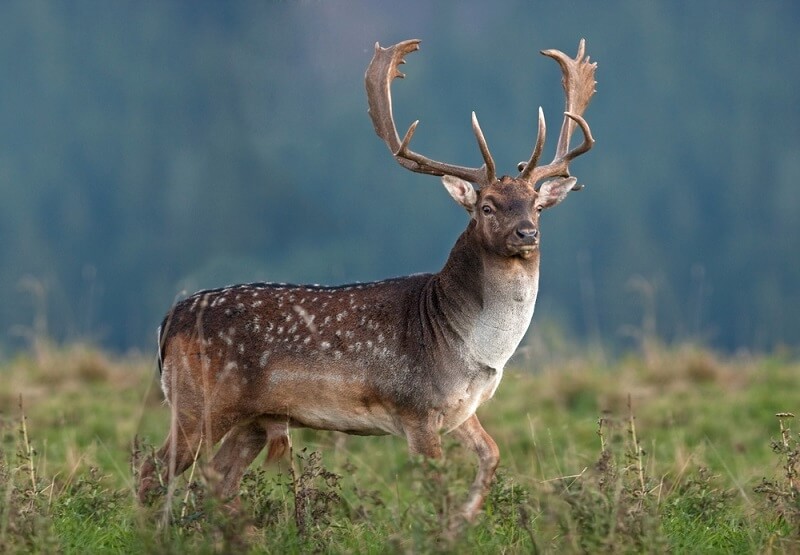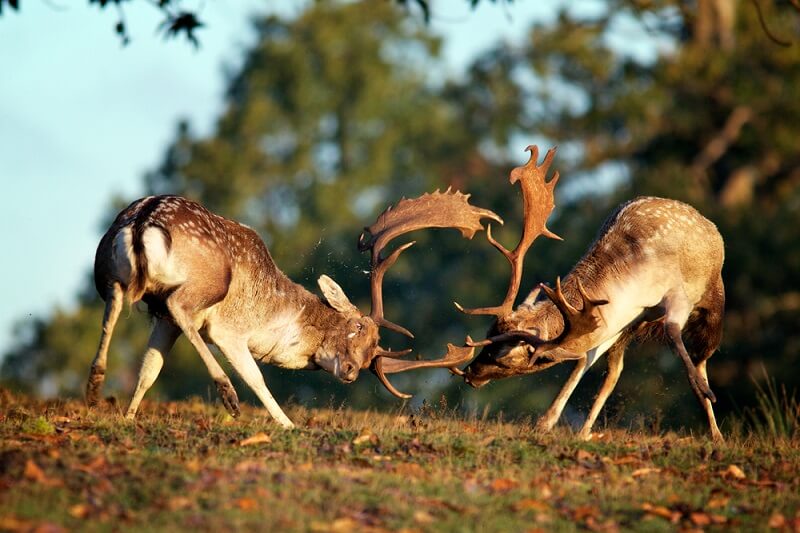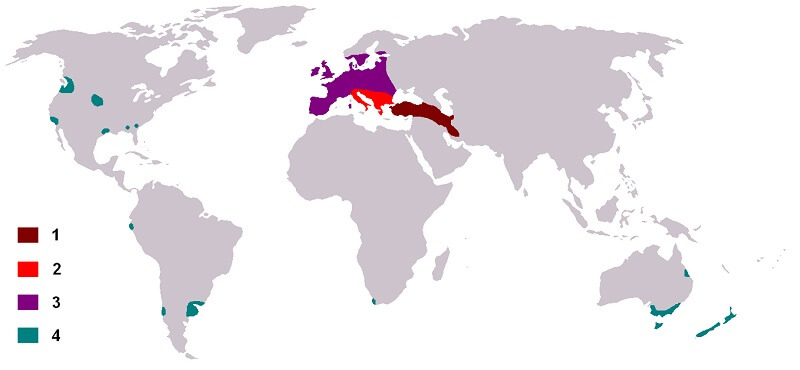
The fallow deer (Dama dama) is a member of the Cervidae family, which includes deer, elk, reindeer, and related species. The male fallow deer is known for its large, shovel-shaped, palmate antlers, and a common color variation includes a light brown coat covered with white spots. However, fallow deer have an extensive range and there is quite a bit of genetic variation in the population as a whole. This leads to several other prominent colorations, including Menil (lighter, more distinct spots), Melanistic (very dark, no spots), and Leucistic (a coat of almost pure white, with a dark nose and eyes). These color variations are tied to a number of different genes, so their influence on survival and reproduction depends entirely on the environment each fallow deer lives in. In the early summer, males will start to develop their antlers. Young bucks only develop two spikes, requiring approximately 4 years before full, palmate antlers form. Males with the largest antlers are able to defend their lek – or breeding territory. During a specific season in the fall known as the rut, males will defend a territory to attract females and win the chance to mate. At the end of the rut, the males shed their antlers – a prize some mount creators appreciate in places where it is legal to collect them. Fallow deer have an interesting evolutionary history in the context of human history. From paleolithic times nearly 500,000 years ago through the Roman Empire and still today, fallow deer have been hunted for food and sport. Today, the fallow deer has been introduced to North America, South America, Africa, and Australia – and wild populations are becoming established in each of these areas. While the deer is considered prized by many hunters, it often competes with local species and may pose a threat. The fallow deer has been part of human history likely since humans were “human.” Not surprisingly, the fallow deer has many lessons about important biological concepts! The following are some of the most important things this species can teach us about biology: A rut is a term specific to some herd animals that have a mating cycle with specific timing. In the case of many deer species – including the fallow deer – the rut starts in fall, allowing females to gestate over winter and give birth in the spring. Babies born in the spring have the most access to new plant growth. While they will feed on their mother’s milk for several months, the babies will quickly develop rumination – the ability to digest complex plant fibers. With this ability, the new fawns will begin devouring large amounts of leafy greens and will quickly grow in size. Females can become sexually mature and reproduce as young as 16 months, whereas males typically do not get the chance to reproduce until they are around 4 years old. Female estrous cycles generally drive the rut, since the females only come into estrous once per year. Thus, males only have a limited opportunity to reproduce and must try to impregnate as many females as possible. During the rut, fallow deer bucks can have different strategies for attracting mates, depending on the environment and local population size. If you look at the map of fallow deer populations below, it might be surprising to see that the fallow deer has several distinct populations that are spread throughout the globe. In fact, the different colors on this map correspond to different expansions of the fallow deer range over time. The historical population in brown (1) represents the oldest known population of fallow deer. These populations have been hunted by humans for hundreds of thousands of years. The red population (2), likely represents an expansion of the original population brought to Greece by ancient civilizations. The purple population (3) represents the Roman expansion of the fallow deer population, with historical records showing that the deer were brought along with Roman armies and were encouraged to form wild populations. These efforts likely carried fallow deer into many parts of Europe. The last population, in teal (4), represents the “modern” introductions of fallow deer that have happened since the early 1900s. The fallow deer has found its way to North America, South America, South Africa, Australia, and New Zealand – most from the import of live animals for hunting. In places like Texas and Argentina, fallow deer are often farmed on ranches. “Hunts” for these deer are sold to wealthy gun-owners, though subsistence hunting of fallow deer has not occurred in a long time. Ecologists must watch these introduced populations carefully, to ensure they do not cause damage like the cane toad, zebrafish, or other invasive species. Like many other cervids, fallow deer practice polygyny. “Poly-” means many, whereas “gyne” means “wive” – together, “many wives.” Animals that practice polygyny form groups with one male for many females. It is opposed to polyandry, where one female controls a group of many males (sometimes seen in fish). A polygynous species can operate under different rules, depending on the environment, species density, and local behaviors. Fallow deer have been observed practicing two kinds of polygyny: Harems and Lekking. Males that form harems stay with the group as it moves about. The male will typically try to keep his females herded together, so no other males can sneak in to get access. By contrast, lekking males defend a valuable territory – or lek – that females wander into. While they are in his territory, only he can try to copulate. Studies have shown that which method a population of fallow deer chooses depends largely on the local environment. When females move long distances in resource-scarce areas, males tend to form harems to protect them. When females are located in an area with many resources, males will tend to protect the best areas where the most females hang out. This is not an easy feat for males either way – researchers have shown that male fallow deer can lose up to 17% of their body weight during the rut, as they try to defend females or territory.
Kingdom
Animalia
Phylum
Chordata
Class
Mammalia
Order
Artiodactyla
Family
Cervidae
Genus
Dama
Species
Dama dama
Niche
Herding Herbivore
Length
55-63 in (140-160 cm)
Weight
66-220 lbs (30-100 kg)
Lifespan
12-16 years
Social Structure
Herds
Conservation Status
Least Concern
Preferred Habitat
Grasslands with sparse forests of the Middle East and Europe, introduced elsewhere
Average Number of Offspring
Typically 1 fawn, though twins are seen in some cases
Main Prey Species
Grasses, vegetation
Predators
Different predators on different continents, but many large cats, canines, and most often humans
The Basics


Interesting Insights from the Fallow Deer!
“The Rut” – A Timing Strategy

Species Transplanted by Humans

Polygyny in Different Ecosystems
